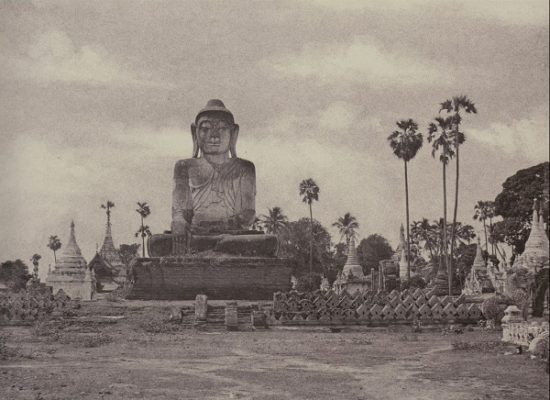Maybe it’s because buildings are only getting glossier and glassier, but urban decay is especially romantic these days. Picturesque photographs of abandoned structures—sometimes dubbed “ruin porn”—pepper Instagram accounts and museum galleries alike. Recently, when the Smithsonian American Art Museum in Washington, D.C., rehung its contemporary gallery, an Andrew Moore photograph of the decrepit Model T Headquarters in Detroit was among the new works.
Reaching further back in time is “Captain Linnaeus Tripe: Photographer of India and Burma, 1852–1860,” at the National Gallery through January 4. The exhibition, which will travel to the Metropolitan Museum of Art in New York and the Victoria and Albert Museum in London, is an unsettling dream in dusky lavenders and tarnished golds, an evocative chronicle of colonial exploration.
Linnaeus Tripe was born in 1822, the ninth of 12 children. His father was a reasonably well-off surgeon, but with seven brothers, Tripe had little inheritance to look forward to, and he joined the British East India Company at the age of 17. Tripe began taking pictures while on an extended home leave and when he returned to India in 1854, he began documenting the temples there. He went on to photograph extensively in Burma, mostly shooting cities, fortresses and other isolated structures. At the time, the Company was voraciously collecting maps, data and drawings of their new territories, and Tripe’s photographs became part of the imperial appetite for information.
In one early photograph, Hullabede: Suli Munduppum from the Northeast, the carved columns of an abandoned temple slouch and lean. The foreground is littered with ornate fallen stones. The vegetation creeps in, threatening to subsume what’s left of the structure. Collapse feels imminent, unavoidable. The absence of humans is keenly felt in Tripe’s photographs—barely any include figures—and the images exude an ominous sense of foreboding: the buildings are there, but where are the people who built and used them? Spending time in the show feels like standing at the center of Stonehenge. The empty fortresses and temples surround the viewer, mute witnesses to the ravages of time.
Destruction hangs over the entire exhibition. Some buildings are in ruins—like the crumbling temples in Mysore—while others no longer exist. Amerapoora, a royal Burmese city, appears perfectly intact in Tripe’s photographs, but would be dismantled just a few years later. The wall text throughout alludes cryptically to the fate of the various structures pictured: “The remains of this building today lie southwest of Mandalay,” and “This building survived until 1945.”
Like the crumbling aqueducts of Rome, these ruined temples and fallen forts testify to the fragility of an empire. Tripe himself mused on impermanence, writing at one point that he wanted to “secure before they disappear [subjects] that are interesting to the Antiquary, Architect, Sculptor Mythologist, and Historian.” But the East India Company was often responsible for the very ruination Tripe sought to counteract. He was an agent of conservation as well as an agent of destruction, a soldier, and an artist, and like so many of the most compelling figures of that period—ambiguous characters like Sir Richard Francis Burton and John James Audubon—Tripe’s blurred roles and apparent ambivalence instill his photographs with their subtle magnetism.
This isn’t a show hinging on a few standout shots, but one in which the roughly 60 works create an atmosphere together. Tripe often photographed his architectural subjects from various distances and angles. At first they might appear as far-off features in a landscape, then seen at closer range, and finally Tripe might give us a detail of an elaborately carved façade. With these perspectival shifts, Tripe makes us feel as though we are advancing on the structure, casting us as conquerors, as pilgrims.
Photography was in its infancy during Tripe’s lifetime: the exposures were long, the equipment expensive, and every step of the temperamental printing process was an exercise in supreme control. Although glass negatives were generally preferred in the 1850s for the sharper images they produced, Tripe used Calotypes, or waxed-paper negatives, that were easier to transport. More than many of his contemporaries, Tripe retouched his negatives extensively, adding highlights to dense foliage, dramatic cumulus clouds to empty skies, and ripples to still water.
These painterly edits don’t just enhance the moodiness of the pictures, they complicate the dry, documentarian nature of Tripe’s assignment. As one of the catalogue essays notes, retouching negatives was a controversial practice at the time, when debates over the “truthfulness” of photography were already raging. Tripe’s photographs are charged with contradictions. The tension between the objective and subjective elements, the personal and professional, maintains their relevance to contemporary viewers. Looking at the work in an age when images are so easily altered, Tripe’s approach feels ahead of its time.
